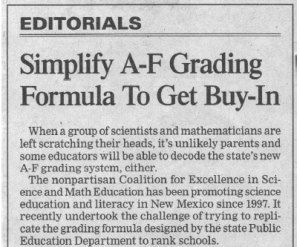And Now, the Los Alamos Monitor…
... has joined the growing list of media outlets giving a nod to CESE's research on New Mexico's proposed A-F Grading System.
The guest viewpoint by Sherry Robinson appeared in the Monitor on August 4th, and is reproduced here for the benefit of CESE readers. It does not appear to have been posted on the Monitor's website, but we will add a link to the article if it is posted in future.
Here are few teasers to whet your appetites for the article!
Now we're starting to hear from parties that don't have a political agenda, and it's official: The state's grading system of schools is too complicated, and the methodology is questionable.
The nonpartisan Coalition for Excellence in Science and Math Education says the state's A-F school grading system is hard to understand, and the system combines elements that are not only apples and oranges but tofu and cheeseburgers. As a result, the results can swing dramatically from year to year.
The coalition's only agenda is to improve math and science education in the state: its membership is weighted with scientists and engineers, many with national lab backgrounds. I've always found them reliable.
Thank you, Sherry Robinson!
Also new this week: Minutes of the 2012 Annual Meeting, featuring outgoing president Terry Dunbar and incoming president Ken Whiton's remarks, as well as a riveting presentation by former State Senator Pauline Eisenstadt on her tumultuous career at the New Mexico roundhouse.
Journal Editorial: “Simplify A-F Grading Formula To Get Buy-In”
 The Albuquerque Journal published an editorial on August 4th, titled "Simplify A-F Grading Formula To Get Buy-In." CESE is mentioned prominently!
The Albuquerque Journal published an editorial on August 4th, titled "Simplify A-F Grading Formula To Get Buy-In." CESE is mentioned prominently!
When a group of scientists and mathematicians are left scratching their heads, it’s unlikely parents and some educators will be able to decode the state’s new A-F grading system, either.
The nonpartisan Coalition for Excellence in Science and Math Education has been promoting science education and literacy in New Mexico since 1997. It recently undertook the challenge of trying to replicate the grading formula designed by the state Public Education Department to rank schools.
It couldn’t, partly because it didn’t have all of the data the PED used, but the group concluded the formula is too complex, adds together incompatible elements and is so sensitive to small changes that unreasonable grade swings from one year to the next can result.
“We’re not talking about a bunch of schmucks here who haven’t seen this stuff before,” said M. Kim Johnson, a retired physicist and an author of the report. “We think it’s all probably above board, but we don’t think the average person, school principal or superintendent could conceivably follow it.”
Please, click through and read the entire editorial.
Thank you, Albuquerque Journal!
